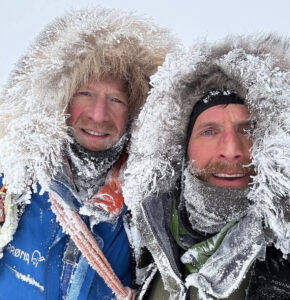A while back, I was looking for relics from the 1913 Karluk Expedition on Wrangel Island. Certain members of that expedition spent the better part of a year on this remote Siberian island after their ship was crushed by ice, and Captain Bob Bartlett played Chopin’s “Funeral March” on his Victrola to accompany its sinking. Those who survived their lengthy stay on Wrangel were rescued by the Canadian schooner King and Winge in September of the following year.
Near Cape Litke, I happened to see not a tattered glove from one of the Karluk’s castaways, but an arctic woolly bear caterpillar (Gynaephora groenlandica) basking on a small rock and looking like it didn’t have a care in the world. This isn’t the same species as the temperate woolly bear (Pyrrharctia isabella), which is commonly thought to predict winter weather — the thicker its brown stripes, the warmer the winter will be. Rather, it was an endemic High Arctic species that doesn’t predict winter weather so much as triumph over it.
I kneeled to get a closer look at this tan-brown, thumb-sized creature. The temperature was slightly below freezing, and like me, it was wearing a parka. Or I should say it was covered with the equivalent of a parka — thick bristly hairs called setae that provide it with external insulation and help it absorb as well as retain heat.
A clever sunbather
Speaking of heat retention, the caterpillar can raise its body temperature 42˚C (75˚F) above the air simply by basking in the sun. It does this basking much of the time when it’s not feeding or searching for food. No high-intensity workouts for it! As the summer progresses, it becomes increasingly chubby, since chubbiness is a good survival morphology in the Arctic.

The Karluk entombed in the ice.
Quite a few members of the Karluk Expedition suffered from hypothermia
during their time on Wrangel. If an arctic woolly bear caterpillar could talk, it
might have said “Try to synthesize some glycerol, guys,” to these shivering men. Glycerol is a compound that the caterpillar manufactures to keep its body cavity from freezing.
Several members of the Karluk Expedition also ended up with Hypervitaminosis A from eating polar bear liver. As a result, they suffered from fatigue and nausea, along with bits of their skin peeling off. If the caterpillar had been able to talk, it might have said “Eat arctic willow leaves,” to these distressed individuals. For the buds and leaves of this creeping shrub (Salix arctica) are its primary food from June until mid-July, after which the buds are gone, and the leaves turn yellow and lack nutrients.

By the time arctic willows turn red and yellow, they lack nutrients. Photo: Jerry Kobalenko
Voluntary hypothermia
In late summer, the caterpillar heads down to a sheltered site close to the permafrost and creates a silken hibernaculum as its winter home. Then it undergoes what Olga Kukal, the world’s leading G. groenlandica expert, calls “voluntary hypothermia.” Frozen solid like a popsicle, it has no worries except for the occasional parasitoid wasp or fly that overwinters as a larva inside it and, while doing so, feeds on it.

Purple saxifrage. The woolly bear eats the leaves of the hardy arctic flower. Photo: Jerry Kobalenko
Come spring, the caterpillar thaws itself out and again begins to eat arctic willow buds and leaves, or if none of these are around, on purple saxifrage leaves. By contrast, I suspect that if Sir John Franklin’s doubtless frozen body is ever found and thawed out, the result would be a foul-smelling heap of carrion incapable of eating a ship’s biscuit or even an Arctic willow leaf.
The first person to spend any time studying arctic woolly bears was James Ross (1800-1862), the naturalist on his uncle Sir John Ross’s 1829 Arctic expedition. Best known for his discovery of the Magnetic North Pole, James Ross collected a number of frozen woolly bears on Fury Island in the Gulf of Boothia. He brought them into the expedition’s warm cabin, where (he wrote) “every one of them returned to life and continued walking about…”
Survives for 14 winters
Ross probably didn’t realize that the caterpillar freezes and thaws each
year for a remarkable 14 years. And whatever the lowest temperature might have been on his uncle’s expedition, it wouldn’t have been nearly as low as the temperature the woolly bear is able to tolerate. What would that temperature be, you might wonder? At least -71˚C (-95˚F)!
After 14 years, the caterpillar has gotten enough resources to pupate and become an arctic woolly bear moth. Compared to a luna moth or a monarch butterfly, this grayish-black moth isn’t a particularly attractive lepidopteran. But what matters to it is not beauty but sex — it must find a mate and lay eggs in a short time because its life span is no more than two weeks. That the moth, unlike the caterpillar, isn’t frost-proof makes it all the more eager to find a mate.
Back to the caterpillar. You would expect it to be present in Inuit folklore, given its seemingly folklorish behavior. Might there be a story about a woman who marries a G. groenlandica because it’s much braver than any man she knows? I never heard such a story, nor did I hear any lore about arctic woolly bear quklurriat (caterpillars) during my meetings with Inuit.
Actually, I did hear one tidbit of lore. In Upernavik, West Greenland, I once met an Inuk who told me his father wore a neck amulet with an arctic woolly bear encased in it. Since the caterpillar can survive extremely frigid conditions, his father figured this amulet might help him do so, too. And it worked, the fellow said with a grin. For shortly after he created the amulet, the government moved his father from a poorly heated turf hut to a well-heated home for elders.
In the end, I didn’t find a single relic from the Karluk Expedition. But I did find something perhaps more interesting than a relic — a furry little creature far better adapted to the cold than almost any other insect, not to mention most members of my own species.






